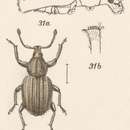Description
(
englanti
)
tarjonnut INOTAXA archive
Rostrum short, stout, the scrobes lateral, deep, descending direct to the lower anterior margin of the eyes; eyes coarsely facetted, not prominent, moderately large; antennæ with a gradually widened scape, reaching the front of the prothorax, the funiculus rather slender, joints 1 and 2 equal in length, 3—7 short and moniliform, the club stout and ovate; mentum small; prothorax transversely oval; scutellum very minute or not visible; elytra short, oval; metasternum short, the episterna very narrowly exposed; ventral segment 2 as long as 3 and 4 united, the first suture feebly arcuate; femora clavate, unarmed; tibiæ sinuate within, strongly unguiculate, and each armed with a row of closely placed stiff bristles at the apex (fig. 31 b); tarsal claws long, divergent; body densely squamose and setose, and also coated with an earthy incrustation, apterous.
Champion in: David Sharp & G. C. Champion, Dec. 1911. Biol. Centr.-Amer.,Coleoptera, vol. 4, pt. 3, Supplement: 342.
- lisenssi
- cc-by-3.0
- tekijänoikeus
- Biologia Centrali-Americana
Physical description
(
englanti
)
tarjonnut INOTAXA archive
This genus also includes Trachyphlœus solitarius, Sharp, both species differing from Trachyphlœus in having the tibiæ closely ciliate with short stiff bristles at the apex (in Trachyphlœus they are armed with from three to five tooth-like spines along the apical margin*), the funiculus more slender, and the prothorax more developed. Hypsometopus, type H. inquinatus, Kirsch (the type of which I have seen), from Colombia, comes near these Mexican insects; but it has the scrobes descending at some distance before the eyes, the antennal club longer, the legs more elongate, &c. The N.-American Phyxelis, Schönh., has superiorly placed scrobes, &c.* A character given by Horn for the single N.-American species, T. asperatus, Boh., and doubtless indicative of their fossorial habits.
- lisenssi
- cc-by-3.0
- tekijänoikeus
- Biologia Centrali-Americana

